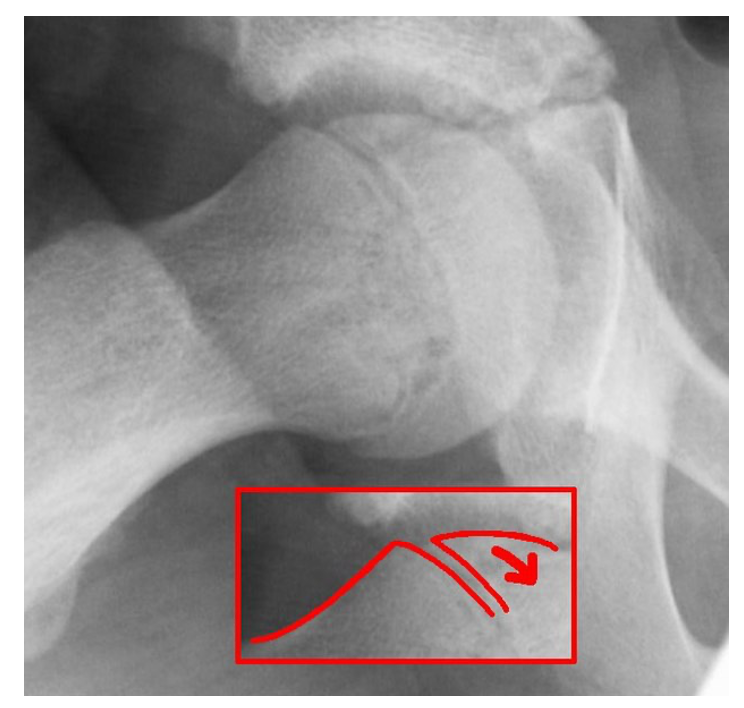Developmental Dysplasia of the hip (DDH)
This represents a spectrum of conditions which affect the proximal femur and acetabulum, seen in new-borns
– The junction between femur and acetabulum is not properly formed which results in deformity which can range from mild dysplasia to subluxation and full dislocation of the hip
– It is much more common in females and more common in the left hip
– The biggest risk factor is breech presentation, as well as a positive family history and oligohydramnios
– Therefore, all breech babies born at 36+ weeks gestation require bilateral hip ultrasound scan at 6 weeks

Symptoms:
– Limp or abnormal gate
– Ability to sublax or fully dislocate hip
– Asymmetry of the skinfolds around the hip
– Limited hip abduction
– Shortening of the affected leg
– If left untreated can lead to early onset arthritis
Diagnosis:
There are 2 tests which are done at birth (NIPE) and which screen for DDH
– If these are positive then do ultrasound scan of the hip (Diagnostic test) or X-ray if child older than 4.5 months
Barlow test:
– This attempts to dislocate an articulated femoral head posteriorly out of the acetabulum
Ortolani test:
– This attempt to relocate a dislocated femoral head back into the acetabulum on abduction

Management:
– If mild dysplasia –> may self-resolve
– If moderate/severe –> Pavlik harness (fixes hip in flexion and abduction)
– For older children or if conservative measures fail –> surgery
Transient Synovitis
This is a condition, known as “irritable hip” which gives transient inflammation of the synovium (inner lining) of the capsule of the hip joint.
– It is the commonest cause of hip pain in children and usually affects children younger than 10 years old.
– It often presents during or following a viral infection giving fever, but the exact cause is unknown
Symptoms:
– Acute-onset hip pain
– May have a grade fever
– Lim with or without pain
– In younger children, may have unexplained crying when changing nappy
– Decreased range of motion (especially internal rotation)
Diagnosis:
It is a diagnosis of exclusion once other more serious causes (e.g., septic arthritis) ruled out
Management:
Rest and anti-inflammatories. The condition usually self-resolves within a few days
Legg-Calve-Perthes’ Disease
This is a condition which is characterised by a disruption of blood supply to the femoral head
– It is classically seen in young boys around the ages of 4-8
– The interrupted blood supply causes avascular necrosis of the capital femoral epiphysis
– Over time, this heals by revascularisation and removal of the necrotic bone, but there is an overall loss of bone mass and a weakening of the femoral head, which can lead to complications later
Symptoms:
– Hip pain (can be bilateral) which may be referred to the knee (can originally be dismissed as growing pains)
– Joint stiffness with reduced range of movement
– Problems with weight bearing giving limping
– Can later lead to osteoarthritis and premature fusion of the growth plates blunting growth
Diagnosis:
– X-ray –> initially shows widening of joint space, increased density in the femoral head
–> in later disease shows small, flattened, fragmented or irregular femoral head
– Bone scan or MRI –> used if normal X-ray but symptoms persist
Management:
The aim is to reduce pressure on the joint till the disease can run its course
– The younger the child the more conservative measures like watching and waiting are preferred
– Options include traction, braces to restore range of motion and physiotherapy
– If irreversible joint damage has occurred –> surgery is required
Slipped Upper Femoral Epiphysis (SUFE)
This is a hip condition which occurs when the epiphysis slips off the femoral head
– It is classically seen in obese teenage boys going through their growth spurt
– It is also associated with endocrine disorders such as hypothyroidism
– Symptoms can present acutely after trauma and also chronically

Symptoms:
– Hip pain –> but can cause isolated groin/knee pain
– Loss of internal rotation of the hip in flexion
– Limp and pain on movement
– If left untreated, can lead to avascular necrosis of the femoral head
Diagnosis:
– X-ray: AP and lateral (frog-leg) views shows displacement of epiphysis
Management:
Open reduction and fixation with a screw through the centre of the epiphysis

